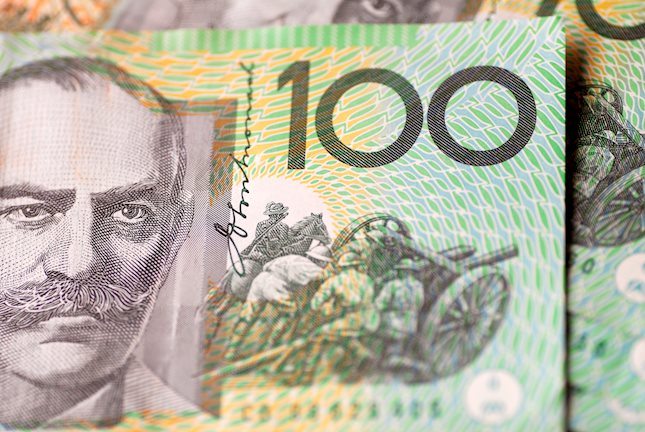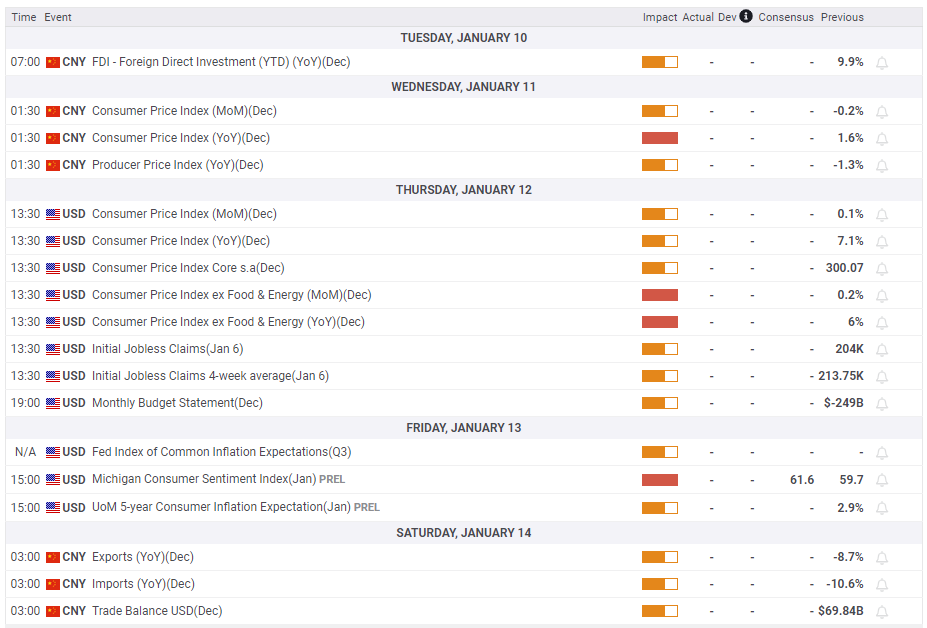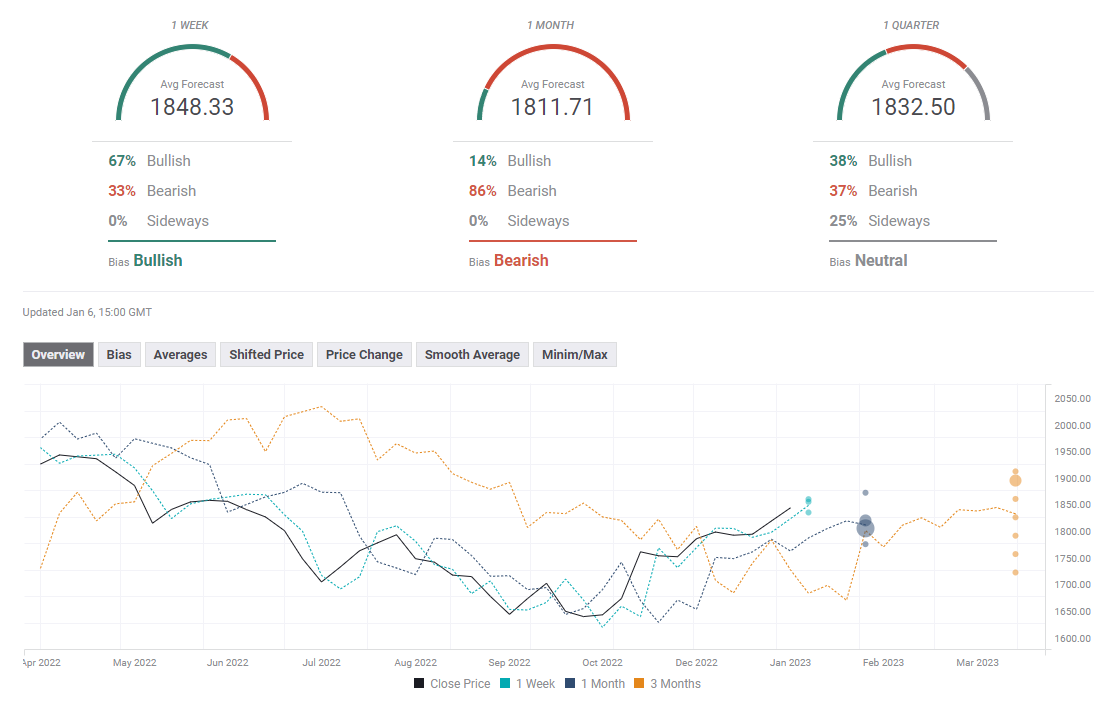- Gold price registered gains for the third straight week.
- Near-term technical outlook suggests that XAU/USD's bullish bias stays intact.
- Consumer Price Index (CPI) data from the US could be next week's big market-moving event.
Gold price started the new year in a volatile manner as investors reassessed the US Federal Reserve (Fed)’s policy outlook following the latest data releases. After having touched its highest level since early June above $1,860 mid-week, XAU/USD fell sharply on Thursday but managed to hold above $1,830. With the US December jobs report and the disappointing ISM Services PMI survey weighing on US Treasury bond yields, the pair regained its traction on Friday and closed the third straight week in positive territory.
What happened last week?
Trading action in financial markets remained subdued on Monday with stock and bond markets in major economies remaining closed in observance of the New Year holiday.
As trading conditions started to normalize on Tuesday, inter-market correlations weakened. Despite the positive shift witnessed in risk sentiment, the US Dollar outperformed its major rivals, including Gold. The benchmark 10-year US Treasury bond yield, however, fell more than 2% on the day and allowed XAU/USD to gather bullish momentum.
The data published by the ISM revealed on Wednesday that the business activity in the manufacturing sector contracted for the second straight month in December. The Employment Index of the ISM’s PMI survey unexpectedly recovered above 5, helping the US Dollar stay resilient and limiting XAU/USD’s upside.
On Thursday, ADP reported that employment in the US private sector rose by 235,000 in December. This reading came in much better than the market expectation of 150,000 and caused investors to reassess the Federal Reserve’s policy outlook. The CME Group FedWatch Tool’s probability of a 25 basis points (bps) rate hike in February declined to 57% from 73% earlier in the week after this data. In turn, the benchmark 10-year US Treasury bond yield staged a rebound and forced the negatively-correlated XAU/USD to erase a portion of its weekly gains.
The US Bureau of Labor Statistics announced on Friday that Nonfarm Payrolls (NFP) rose by 223,000 in December, compared to the market expectation of 200,000. Further details of the report showed that the Average Hourly Earnings declined to 4.6% from 4.8% (revised from 5.1%) in November. Despite the upbeat NFP print, soft wage inflation caused the 10-year US T-bond yield to turn south and opened the door for a rebound in XAU/USD. Finally, the ISM Services PMI declined to 49.6 in December from 56.5 in November. More importantly, the inflation component, Prices Paid Index, dropped to 67.6 from 70 and came in much lower than the market expectation of 71.5. The mixed jobs report and the dismal PMI survey caused the US Dollar to weaken against its rivals and fueled another leg higher in XAU/USD.
Next week
The United States economic docket will not offer any high-impact macroeconomic data releases in the first half of next week. On Thursday, the US Bureau of Labor Statistics (BLS) will release the Consumer Price Index data for December. On a monthly basis, the Core CPI, which excludes volatile food and energy prices, is expected to rise by 0.3% following November’s increase of 0.2%.
In October and November, monthly Core CPI rose at a softer pace than expected and investors decided that it was time for the Federal Reserve to take its foot off the gas pedal. Although Fed policymakers have been reiterating that they are not expecting a rate cut in 2023, one more soft core inflation reading should weigh on the US Dollar and trigger another leg higher in XAU/USD.
The minutes of the December policy meeting revealed earlier in the week that most policymakers welcomed inflation easing in October and November but agreed that it would take "substantially more evidence" of progress to confirm the downward path.
On the other hand, a monthly increase of 0.5% or higher in core inflation should lift US Treasury bond yields and cause Gold price to turn bearish.
Ahead of the weekend, the University of Michigan’s preliminary Consumer Sentiment Survey for January will be looked upon for fresh impetus. Rather than the headline Consumer Confidence Index, market participants are likely to pay close attention to the 5-year Consumer Inflation Expectation component, which stood at 2.9% in December. It’s unlikely to see a significant change in that number but a short-lived and straightforward market reaction could be witnessed with an uptick in the long-run inflation expectation lifting the US Dollar against Gold and vice versa.
Gold price technical outlook
XAU/USD's near-term technical outlook remains bullish with the Relative Strength Index (RSI) indicator on the daily chart rising above 60. Additionally, the pair holds comfortably above the 20-day Simple Moving Average (SMA) while continuing to follow the ascending trend line.
The $1,860 static level aligns as the first resistance. Once XAU/USD confirms that level as support, it could target $1,880 (Fibonacci 61.8% retracement of the long-term downtrend), $1,900 (psychological level) and $1,920 (former support, static level).
In case Gold price falls below $1,810 (20-day SMA), the downward correction could extend toward $1,800 and $1,780 (Fibonacci 38.2% retracement, 200-day SMA).
Gold price forecast poll
Despite XAU/USD's bullish start to the year, the FXStreet Forecast Poll points to a bearish bias over the one-month outlook with the average target sitting at $1,811.
Information on these pages contains forward-looking statements that involve risks and uncertainties. Markets and instruments profiled on this page are for informational purposes only and should not in any way come across as a recommendation to buy or sell in these assets. You should do your own thorough research before making any investment decisions. FXStreet does not in any way guarantee that this information is free from mistakes, errors, or material misstatements. It also does not guarantee that this information is of a timely nature. Investing in Open Markets involves a great deal of risk, including the loss of all or a portion of your investment, as well as emotional distress. All risks, losses and costs associated with investing, including total loss of principal, are your responsibility. The views and opinions expressed in this article are those of the authors and do not necessarily reflect the official policy or position of FXStreet nor its advertisers. The author will not be held responsible for information that is found at the end of links posted on this page.
If not otherwise explicitly mentioned in the body of the article, at the time of writing, the author has no position in any stock mentioned in this article and no business relationship with any company mentioned. The author has not received compensation for writing this article, other than from FXStreet.
FXStreet and the author do not provide personalized recommendations. The author makes no representations as to the accuracy, completeness, or suitability of this information. FXStreet and the author will not be liable for any errors, omissions or any losses, injuries or damages arising from this information and its display or use. Errors and omissions excepted.
The author and FXStreet are not registered investment advisors and nothing in this article is intended to be investment advice.
Recommended Content
Editors’ Picks

AUD/USD hangs near multi-year low as traders await US NFP report
AUD/USD consolidates just above its lowest level since October 2022 as traders move to the sidelines ahead of Friday's release of the closely-watched US NFP report. In the meantime, rising bets for an early RBA rate cut, China's economic woes, US-China trade war fears, geopolitical risks and a softer risk tone act as a headwind for the Aussie.

USD/JPY bulls turn cautious near multi-month peak ahead of US NFP
USD/JPY moves little following the release of household spending data from Japan and remains close to a multi-month top amid wavering BoJ rate hike expectations. Furthermore, the recent widening of the US-Japan yield differential, bolstered by the Fed's hawkish shift, undermines the lower-yielding JPY and acts as a tailwind for the currency pair amid a bullish USD.

Gold price consolidates below multi-week top; looks to US NFP for fresh impetus
Gold price enters a bullish consolidation phase below a four-week top touched on Thursday as bulls await the US NFP report before placing fresh bets. In the meantime, geopolitical risks, trade war fears and a weaker risk tone might continue to act as a tailwind for the safe-haven XAU/USD.

Ripple's XRP plunges over 4% following funding rates decline
Ripple's XRP declined 4% on Friday following a decline in its funding rates. The remittance-based token could decline to test the $2.17 support level if the crypto market decline extends.

How to trade NFP, one of the most volatile events Premium
NFP is the acronym for Nonfarm Payrolls, arguably the most important economic data release in the world. The indicator, which provides a comprehensive snapshot of the health of the US labor market, is typically published on the first Friday of each month.

Best Forex Brokers with Low Spreads
VERIFIED Low spreads are crucial for reducing trading costs. Explore top Forex brokers offering competitive spreads and high leverage. Compare options for EUR/USD, GBP/USD, USD/JPY, and Gold.


